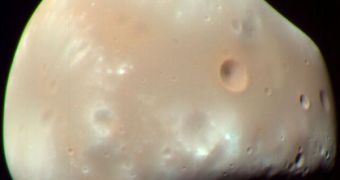Exploring the Red Planet is something that space agency expect to be able to do with humans starting in the mid-2030s. By 2035 or 2036, astronauts need to set food on Mars, and finally begin exploring our neighboring planet.
But there are still some large obstacles to pass before that happens, experts say, and so maybe it wouldn't be wise to attempt a landing mission directly. Experts are now proposing that we first visit the Martian moon Deimos instead.
This space rock will play an essential role in informing next missions bound for Mars, say engineers from the Denver-based Lockheed Martin Space Systems. They are convinced that landing on Deimos, and setting shop there, will finally help experts validate technologies that are critical for exploration.
The interesting thing about this moon is that experts will be able to visit it using both humans and robots, or any combination of the two. NASA is one of the agencies that has a vested interest in reaching Mars as soon as possible.
It is already exploring Mars with rovers, landers and orbiters, so undoubtedly the organization has the know-how to land a rover on Deimos as well. The plan to explore this moon is called Project Red Rock, Space reports.
The desire to reach Mars was announced by US President Barack Obama in April 2010, during a speech he held at the NASA Kennedy Space Center (KSC), in Florida. He selected to give the address there because the facility is the home of the American shuttle fleet, a symbol of space exploration.
“By the mid-2030s, I believe we can send humans to orbit Mars and return them safely to Earth. And a landing on Mars will follow. And I expect to be around to see it,” he said at the event.
Project Red Rock is Lockheed's response for Obama. “Sending astronauts to Deimos will demonstrate key technologies that will be needed for subsequent human Mars landings,” a project fact sheet shows.
According to mission specifications, astronauts could set up a base at the Deimos arctic circle, where the arctic day lasts for 10 months. This means that simple, solar-powered installations can be mounted, eliminating the need for nuclear generators as primary sources of electricity.
Such a mission “will demonstrate key technologies that will be needed for subsequent human Mars landings, such as reliable life-support recycling systems, long-term cryogenic propellant storage, and the biomedical technology to protect astronauts from the effects of microgravity and space radiation,” Lockheed adds.
Both Deimos and Mars' other moon, Phobos. “are natural space stations in Mars orbit, ready for us to occupy, and from there we can efficiently explore the Red Planet,” concludes the chairman of the Mars Institute, Pascal Lee.

 14 DAY TRIAL //
14 DAY TRIAL //